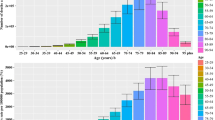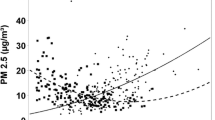Abstract
Mortality rates due to chronic obstructive pulmonary disease (COPD) for males and females in standard metropolitan statistical areas are highest in two broad regions of the U.S. One is the southeast, with age-adjusted rates high in Georgia and north Florida but decreasing toward south Florida; the other is the western plains, with rates high in Colorado and north Texas but decreasing toward south Texas. Rates are generally low in the northeast, upper midwest, and far west, as well as in the largest cities of these regions. These geographic patterns suggest that atmospheric environmental conditions may contribute to the risk of COPD. Based on measured aerosol characteristics and atmospheric chemical reasoning, it is argued that ambient air in the high COPD regions may be especially irritating to the respiratory tract because of fine particles that contain the reaction products of acid air pollutants. In the southeast, sulfuric acid aerosol concentrations are high, apparently because of a sunny warm humid climate that favors rapid oxidation of sulfur dioxide as well as the region's proximity to large primary air pollution sources further north. Particulate sulfur is also associated with soil mineral constituents. In the western plains, concentrations of alkaline dust are high because of soil erosion during windy dry conditions. Acid air pollutants can be scavenged to mineral particle surfaces and form chemical reaction products that may include solubilized mineral aluminum. These may be inhaled and deposited in the respiratory tract so as to contribute to COPD mortality risk.
Similar content being viewed by others
References
Ahlberg MS, Leslie ACD, Winchester JW (1978) Characteristics of sulfur aerosol in Florida as determined by PIXE analysis. Atmos Environ 12:773–777
Blot WJ, Davies JE, Brown LM, Nordwall CW, Bulatti E, Ng A, Fraumeni JF Jr (1982) Occupation and the high risk of lung cancer in northeast Florida. Cancer 50:364–371
Calvert J panel chairman (1983). Acid Deposition Processes in Eastern North America. National Academy Press, Washington, DC, 375 pp
FADS (1986) Final Report: A Synthesis of the Florida Acid Deosition Study. Florida Electric Power Coordinating Group, Inc, Tampa
Fan Song-miao (1985) Acidity of Atmospheric Aerosols in North Florida. MS Thesis, Dept of Oceanography, Florida Slate University, Tallahassee
Ferek RJ, Lazrus AL, Haagenson PL, Winchester JW (1983) Strong and weak acidity of aerosols collected over the northeastern United States. Environ Sci Technol 17:315–324
Gillette DA and Hanson KJ (1988) Spatial and temporal variability of dust production caused by wind erosion in the United States. J Geophys Res (in press).
HHS (1985) Average age-adjusted death rates for chronic obstructive pulmonary diseases and allied conditions (490-496) 1979–81. Table 803, pages 1313–1340, dated 85/08/09, for 305 Standard Metropolitan Statistical Areas. Unpublished document from U.S. Dept of Health & Human Services, Public Health Service, National Center for Health Statistics, Mortality Statistics Branch, Hyattsville MD 20782
Lau NC, Charlson RJ (1977) On the discrepancy between back—ground atmospheric ammonia gas measurements and the existence of acid sulfates as a dominant atmospheric aerosol. Atmos Environ 11:475–478
Ochiai EI (1987) General principles of biochemistry of the elements. Plenum, New York
Riggan WB, Van Bruggen J, Acquavella JF, Beauier J, Mason TJ (1983) U.S. cancer mortality rates and trends 1950–1979. National Cancer Institute and U.S. Environmental Protection Agency, Washington, DC
Robbins SL, Cotran RS (1979) Pathologic basis of disease, 2nd edn. Saunders, Philadelphia, p 827
Schindler DW (1988) Effects of acid rain on freshwater ecosystems. Science 239:149–157
Schlesinger WH, Peterson WT (1988) Ion and sulfate-isotope ratios in arid soils subject to wind erosion in the south-western USA. Soil Sci Soc Am J 52:54–58
Tang IN, Munkelwitz HR, and Davis JG (1978) Aerosol growth studies-IV. Phase transformation of mixed salt aerosols in a moist atmosphere. J Aerosol Sci 9:505–511
Winchester JW (1983) Sulfur, acidic aerosols, and acid rain in the eastern United States. In: Schwartz SE (ed) Trace atmospheric constituents: properties, transformations, and fates (Advances in Environmental Science and Technology, Vol. 12). Wiley, New York, pp 269–301
— (1988) Aerosol sulfur association with aluminum in eastern North America; evidence for solubilization of atmospheric trace metals before deposition. In: Adriano DC and Lindberg SE (eds) Acid precipitation, Vol. 3, Chemistry and transport (Advances in Environmental Science). Springer-Verlag, New York (in press)
Winchester JW, Wang MX (1988) Acid-base balance of aerosol components of the Asia-Pacific region. Tellus (in press)
Author information
Authors and Affiliations
Rights and permissions
About this article
Cite this article
Winchester, J.W. Regional anomalies in chronic obstructive pulmonary disease; comparison with acid air pollution particulate characteristics. Arch. Environ. Contam. Toxicol. 18, 291–306 (1989). https://doi.org/10.1007/BF01056216
Received:
Revised:
Issue Date:
DOI: https://doi.org/10.1007/BF01056216




